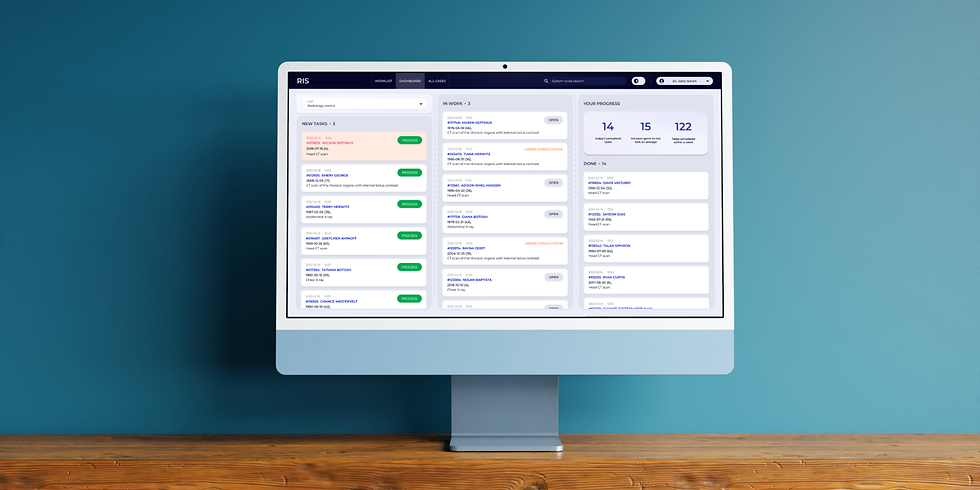RIS Software redesign
Redefining Radiology Information Systems for Cancer Treatment Centers
Type of Project
Team project for a healthcare client
Tools Used
Figma, Miro, DICOM SR and OHIF viewers, IA tools, Confluence
Role
UX/Product Designer
Duration
6 months
.png)

Designing the Solution
Strategy & Ideation
-
Personas: Developed personas for key users like Marie and Dr. Almeida to guide the design.
-
Journey Mapping: Visualized workflows to identify pain points and opportunities for improvement.
-
Initial Wireframes: Sketched layouts focusing on simplified navigation and task prioritization.
1
UI & Visual Design
-
Clean Interface: Designed a modern, accessible UI with both light and dark modes.
-
Enhanced Readability: Used accessible typography and colour contrast for better usability.
-
Consistency: Built a modular design system to ensure a cohesive experience across screens.
3
-
Clickable Prototypes: Created interactive prototypes simulating key workflows.
-
Usability Testing: Conducted sessions with target users, gathering actionable feedback.
-
Iterative Improvements: Simplified layouts and enhanced data visibility based on testing insights.
Prototyping & Testing
2
Integration with Tools
-
DICOM SR: Incorporated seamless imaging data reporting.
-
OHIF Viewer: Embedded for faster and more intuitive image analysis.
-
AI Tools: Integrated diagnostic aids to enhance workflow efficiency.
4
-
Dynamic Dashboards: Consolidated patient data for quick access.
-
Seamless Imaging Tools: Integrated OHIF viewer and AI-powered diagnostics.
-
Real-Time Updates: Improved case tracking and task management.
Key Features
.png)
.png)
The Outcome
-
Reduced Task Times: Workflow completion times decreased by 35%.
-
Increased Accuracy: Errors in data entry and navigation were minimized.
-
User Satisfaction: Feedback indicated a 40% increase in satisfaction scores.

Reflection
The RIS Software Project taught me how to balance technical constraints with user needs while delivering impactful solutions. Collaborating with developers to integrate modern tools like DICOM SR and OHIF Viewer required creative problem-solving. Overcoming user resistance highlighted the value of involving stakeholders early and often to build trust and confidence.
By focusing on iterative design and prioritizing user feedback, the new RIS streamlined workflows, reduced errors, and improved satisfaction. This experience reinforced the importance of empathy and collaboration in crafting solutions that genuinely enhance daily work for healthcare professionals.
Research & Insights
Key Findings:
-
Navigation complexity was the biggest pain point, increasing task completion times.
-
Real-time data visibility was critical but lacking in the current system.
-
Users needed better integration with imaging tools to streamline workflows
User Interviews
Spoke with doctors, nurses, and administrators to understand their daily challenges
Contextual Observations
Observed radiology departments to identify inefficiencies in workflows
Competitive Analysis
Benchmarked modern RIS platforms to identify opportunities for innovation
Understanding the Users
Radiology Department Nurse
Marie

-
Role: Manages patient cases and updates records.
-
Pain Points: Delayed access to updates and frequent navigation errors.
-
Needs: A real-time dashboard and clear task prioritization tools.
Radiologist
Dr. Almeida

-
Role: Reviews imaging data and prepares diagnostic reports.
-
Pain Points: Scattered data and slow image loading hinder decision-making.
-
Needs: A unified interface with seamless imaging data integration.
The Goal
To design and implement a user-friendly RIS that:
-
Simplifies navigation and reduces errors.
-
Enhances productivity by streamlining workflows.
-
Integrates seamlessly with modern imaging and diagnostic tools.
-
Empowers healthcare professionals to focus on patient outcomes rather than system limitations.
Problem
The legacy RIS software had been in use for decades and was riddled with challenges:
-
Complex Navigation: Doctors and nurses struggled to access critical information quickly, delaying care.
-
Frequent Errors: The cluttered interface and confusing workflows led to mistakes in data entry and retrieval.
-
Time Wasted: Valuable time was lost as users navigated through convoluted processes.
-
Outdated Technology: The system lacked integration with modern tools like DICOM SR, the OHIF viewer, and AI-powered diagnostic aids.
These issues created a pressing need for a solution that was intuitive, efficient, and technologically advanced.

overview
Cancer treatment centers rely heavily on Radiology Information Systems (RIS) to manage patient data and imaging workflows. However, many existing systems are outdated, inefficient, and difficult to use, leading to frustration, errors, and wasted time for medical professionals. This project aimed to replace an outdated RIS with a modern, user-friendly platform that empowers doctors, nurses, and administrators to work more efficiently and focus on what matters most: patient care.